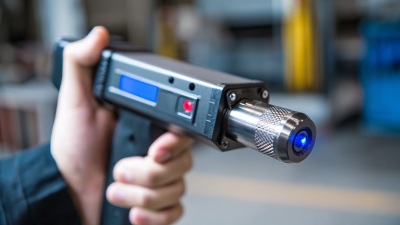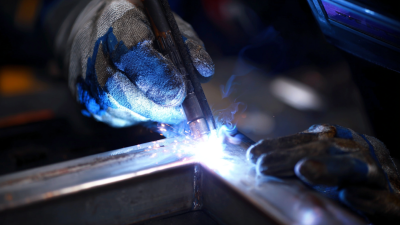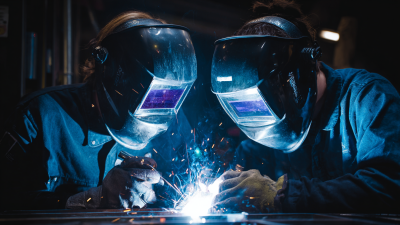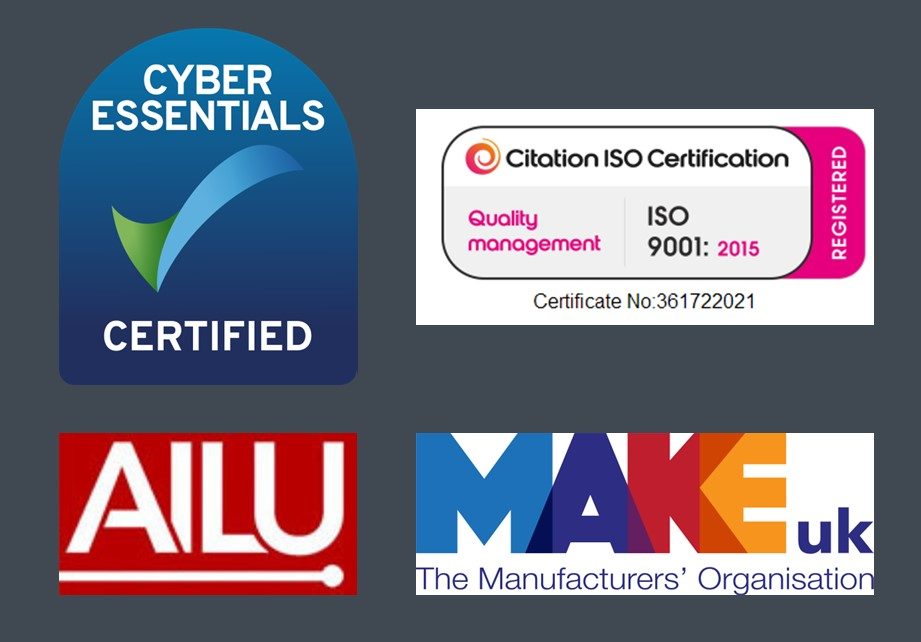Understanding the Benefits of Fiber Laser Welding Machines: A Comprehensive Guide for Modern Fabrication
The advent of advanced technologies in the fabrication industry has revolutionized traditional welding methods, with the fiber laser welding machine emerging as a game-changer.
According to a report by ResearchAndMarkets, the global laser welding market is projected to reach $1.5 billion by 2025, driven by the increasing demand for precise and efficient welding processes across various sectors, including automotive, aerospace, and electronics.
 The fiber laser welding machine, known for its high-power density and exceptional beam quality, significantly enhances productivity and reduces thermal distortion, making it an ideal solution for modern manufacturing.
The fiber laser welding machine, known for its high-power density and exceptional beam quality, significantly enhances productivity and reduces thermal distortion, making it an ideal solution for modern manufacturing.
Moreover, a study conducted by Allied Market Research indicates that the adoption of fiber laser technology has improved welding speed by up to 10 times compared to traditional techniques, resulting in better cost efficiency and quicker turnaround times. This efficiency coupled with minimal maintenance needs and lower operational costs makes fiber laser welding machines an attractive investment for businesses striving to maintain a competitive edge in today’s fast-paced market. As industries continue to evolve, understanding the benefits and applications of these machines will be crucial for manufacturers seeking to optimize their production processes and improve product quality.
Benefits of Fiber Laser Welding Machines in Modern Fabrication Processes
Fiber laser welding machines have revolutionized modern fabrication processes by offering unparalleled precision and efficiency. One of the primary benefits is their ability to deliver high-quality welds with minimal heat input. This not only results in less distortion and damage to the surrounding material but also ensures a strong bond between components, making it ideal for intricate designs and diverse applications. The concentrated beam of the fiber laser allows for deep penetration and fast welding speeds, significantly reducing production time.
Additionally, fiber laser welding machines are highly versatile and adaptable to various materials, including metals like stainless steel, aluminum, and even some plastics. This flexibility allows manufacturers to streamline operations and reduce the need for multiple types of equipment. The low maintenance requirements and superior energy efficiency of fiber laser systems further enhance their appeal, as they translate into lower operational costs and increased sustainability. As companies seek innovative solutions to improve productivity and quality, fiber laser welding stands out as a critical asset in modern fabrication.
Understanding the Benefits of Fiber Laser Welding Machines
| Benefit | Description | Application Area |
|---|---|---|
| High Precision | Fiber laser welding provides exceptional accuracy with minimal heat affected zones. | Aerospace, Automotive |
| Speed | Fast processing speeds reduce overall production time compared to traditional welding. | Manufacturing, Fabrication |
| Lower Operating Costs | Less energy consumption and lower maintenance costs due to fewer moving parts. | Construction, Shipbuilding |
| Versatility | Can weld a variety of materials, including metals and plastics. | Electronics, Jewelry |
| Ease of Automation | Easily integrable into automated systems for enhanced production efficiency. | Robotics, Assembly Lines |
| Minimal Distortion | Reduces the risk of warping parts due to lower thermal input. | Metalworking, Aerospace |
Key Differences between Fiber Laser Welding and Traditional Welding Techniques
 Fiber laser welding and traditional welding techniques such as MIG and TIG welding present distinct differences that significantly impact fabrication efficiency and quality. One of the primary advantages of fiber laser welding is its precision. The focused beam of laser light allows for exceptionally fine welds with minimal heat input, reducing the risk of warping and distortion in the materials being joined. In contrast, traditional methods often require greater heat application, which can lead to larger heat-affected zones and subsequent material deformation.
Fiber laser welding and traditional welding techniques such as MIG and TIG welding present distinct differences that significantly impact fabrication efficiency and quality. One of the primary advantages of fiber laser welding is its precision. The focused beam of laser light allows for exceptionally fine welds with minimal heat input, reducing the risk of warping and distortion in the materials being joined. In contrast, traditional methods often require greater heat application, which can lead to larger heat-affected zones and subsequent material deformation.
Another critical difference lies in the speed and automation capabilities. Fiber laser welding machines can operate at much higher speeds compared to traditional welding processes due to their faster traveling capabilities and continuous operation. This enhanced speed translates to improved throughput in manufacturing environments. Furthermore, the integration of automation in fiber laser welding systems enables consistent results and allows for complex join designs that may be challenging to achieve with conventional welding methods.
This makes fiber laser technology particularly advantageous for industries requiring high volume and precision, such as aerospace and automotive manufacturing, where quality and efficiency are paramount.
Industry Growth: Impact of Fiber Laser Technology on Manufacturing Efficiency
The impact of fiber laser technology on manufacturing efficiency is profound, leading to significant growth across various industries. As the market for laser technology is projected to surge to USD 37.7 billion by 2033, companies are increasingly adopting fiber lasers for their cutting and welding processes. This transition is driven by the technology's ability to enhance precision, reduce cycle times, and lower operational costs. Furthermore, fiber lasers contribute to improved quality of the finished products, making them an ideal choice for sectors such as aerospace, automotive, and heavy machinery.
Tips for Businesses: When considering the adoption of fiber laser technology, it's vital to assess your specific application needs and explore the latest innovations in the field. Engaging with suppliers who provide tailored solutions can also ensure that you maximize the efficiency and output of your manufacturing processes. Additionally, staying updated on market trends can help you align your strategy with emerging opportunities, thereby enhancing your competitive edge.
Investments in advanced fiber laser systems are expected to pay off quickly in terms of productivity. With the laser cutting machine market registering a steady growth rate, businesses that incorporate these technologies can expect not just enhanced output but also adaptability to evolving manufacturing needs. As the landscape of industrial automation shifts, companies embracing fiber laser solutions stand to benefit from both increased efficiency and longer-term sustainability.
Cost Efficiency: Analyzing the Long-Term Savings of Fiber Laser Welding Systems
Fiber laser welding machines have gained popularity in modern fabrication due to their cost efficiency and long-term savings. One of the primary advantages of these systems is the reduction in operational expenses. Fiber lasers consume significantly less energy compared to traditional welding methods, which translates to lower electricity bills for businesses. Additionally, their high-speed processing capabilities mean that projects can be completed in a fraction of the time normally required, leading to increased productivity and quicker turnaround times.
Moreover, the precision of fiber laser welding reduces the need for rework and material wastage. Since these machines offer cleaner cuts and stronger welds, manufacturers face fewer quality control issues, cutting down on both time and costs associated with defects. Over time, the cumulative savings from using fiber laser systems can be substantial, making them a smart investment for businesses looking to enhance efficiency while minimizing long-term expenses. As the technology continues to evolve, the financial advantages of fiber laser welding will likely become even more pronounced, solidifying their role in the future of fabrication processes.
Cost Efficiency of Fiber Laser Welding Machines
This chart illustrates the cost efficiency analysis of fiber laser welding machines across several dimensions, highlighting initial investment, yearly maintenance, energy consumption, production speed, and projected long-term savings.
Applications of Fiber Laser Welding Across Various Industries and Markets
Fiber laser welding machines have found a significant place across various industries due to their precision and efficiency. In the automotive sector, for instance, the adoption of fiber laser technology is projected to grow at a CAGR of 15.5% from 2021 to 2027, according to a report by ResearchAndMarkets. This rapid growth is driven by the need for lightweight and durable materials, where fiber laser welding excels by producing strong, clean seams that improve performance and aesthetics in automotive assemblies.

In addition to automotive applications, the aerospace industry benefits substantially from fiber laser welding. A study by MarketsandMarkets indicates that the aerospace sector's demand for advanced welding technologies is expected to reach $250 million by 2025. Fiber lasers enable the welding of high-strength alloys and composites, critical for reducing weight while maintaining structural integrity in aircraft components. Furthermore, industries such as electronics and medical devices are increasingly integrating fiber laser welding for micro-welding applications, which ensure high precision and minimal thermal distortion, enhancing the overall quality of the end products.
Related Posts
-

Exploring the Advantages of Hand Held Laser Welding Machines: Efficiency and Precision Unleashed
-

Revolutionizing Manufacturing: How Welding Automation Increases Efficiency by 30% and Reduces Costs
-

Unveiling the Future: How Laser Welders Revolutionize Modern Manufacturing Techniques
-

Mastering Tig Welding Aluminum Techniques for Stronger Joints and Improved Performance in Every Project
-

Exploring the Future: How Handheld Laser Welders Are Revolutionizing DIY Projects
-

Unlocking the Secrets: MIG vs. TIG Welder - Which Welding Technique Reigns Supreme?


